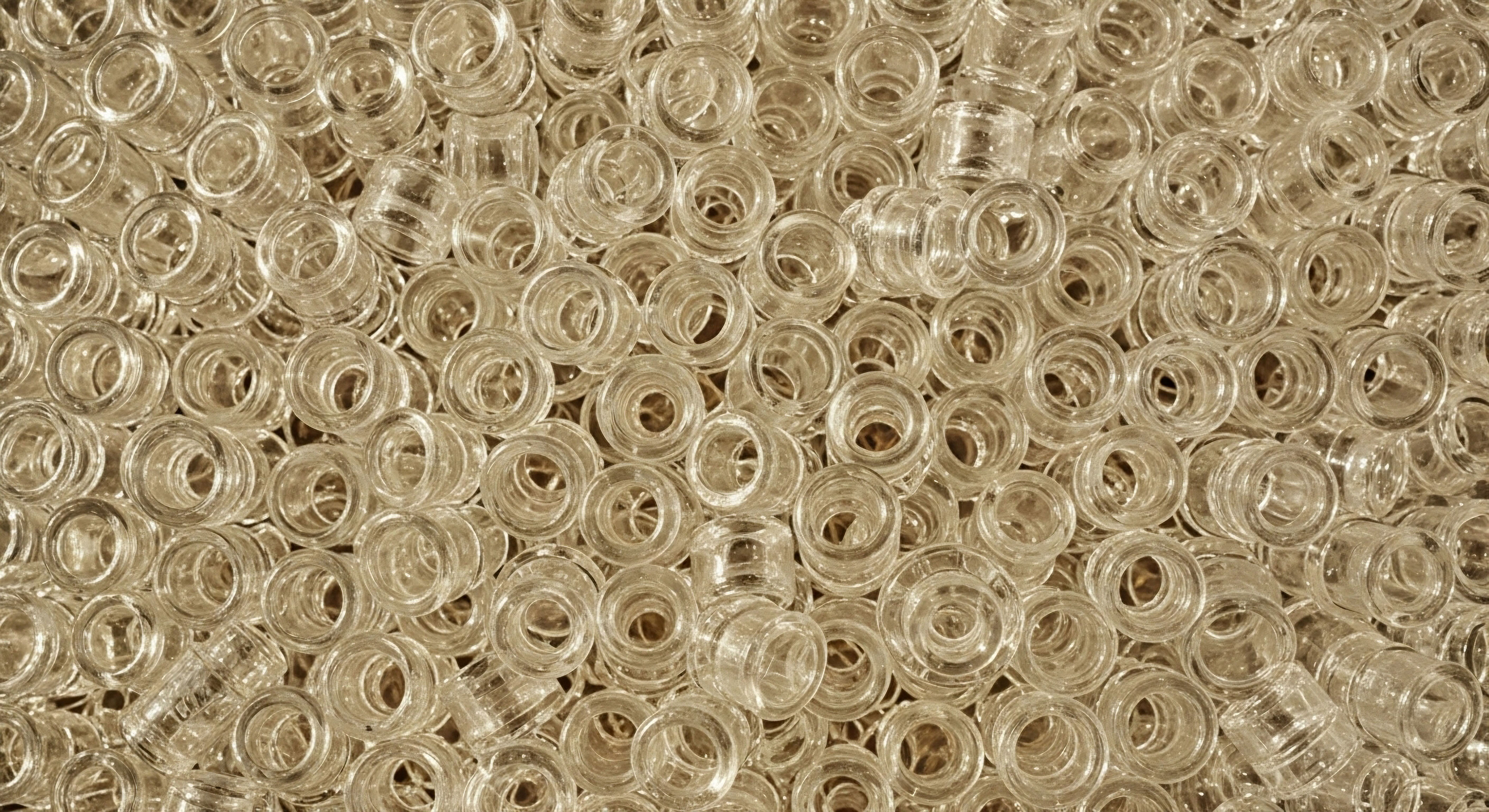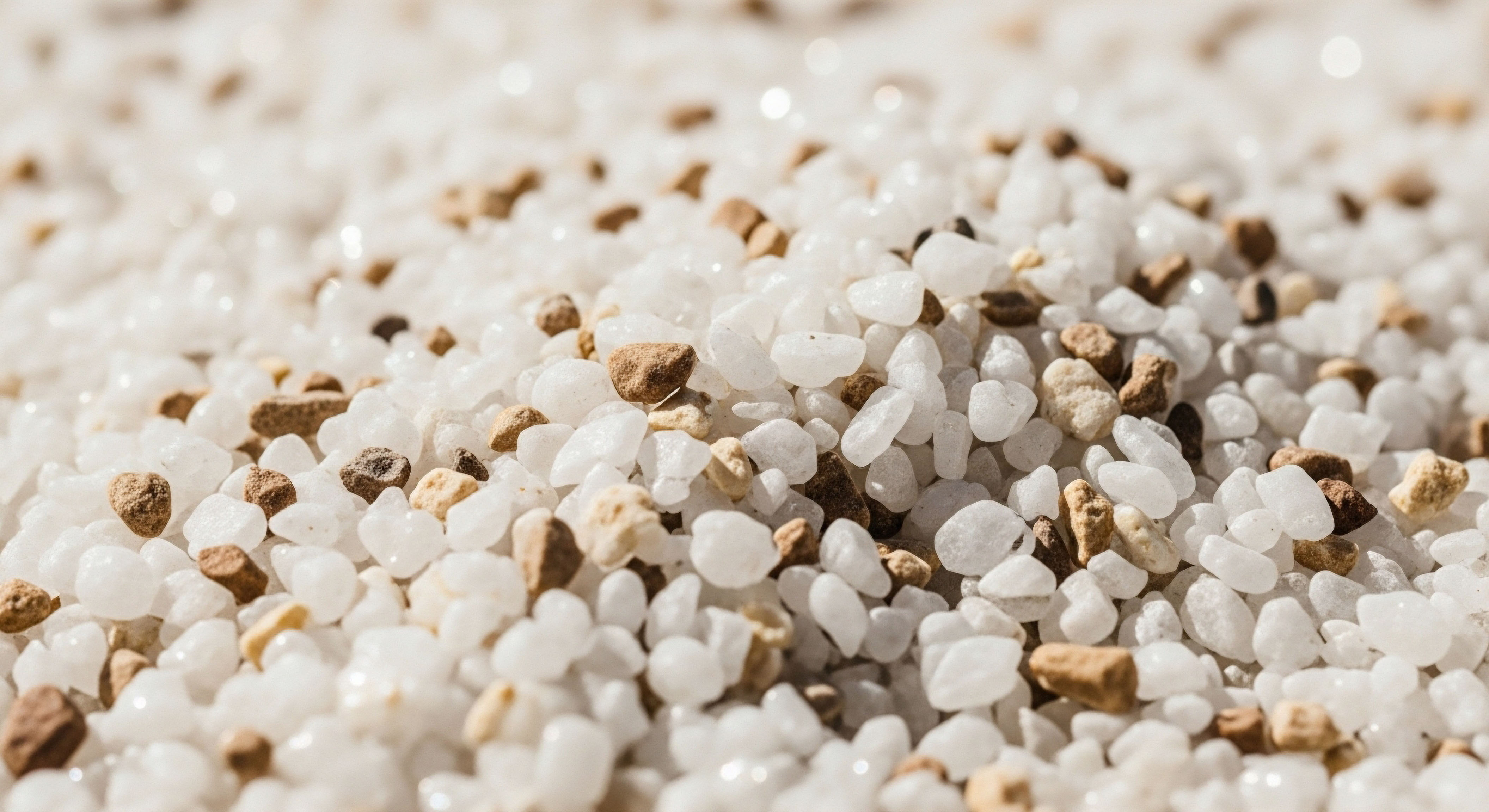

Fundamentals
Have you ever experienced those subtle shifts within your body, a feeling of being slightly off balance, perhaps a persistent chill that defies warm clothing, or an unexpected flush that leaves you feeling unsettled? These sensations, often dismissed as minor inconveniences, can sometimes be whispers from your intricate internal systems, signaling a delicate interplay at work.
For many navigating the landscape of hormonal health, these seemingly small temperature excursions, whether external or internal, hold a deeper significance. They are not merely environmental conditions; they represent forces that can influence the very biochemical messages your body relies upon for vitality and function.
Understanding your own biological systems is a profound step toward reclaiming well-being. The human body operates as a remarkably precise machine, a complex network of communication where hormones serve as vital messengers. These chemical signals orchestrate nearly every physiological process, from your energy levels and mood to your reproductive health and metabolic efficiency. When we consider supporting these systems through targeted hormonal optimization protocols, the stability and integrity of these therapeutic agents become paramount.
Temperature, a seemingly simple variable, plays a surprisingly influential role in this delicate balance. Think of it as a thermostat for your internal pharmacy. Just as certain foods spoil outside of refrigeration, many therapeutic compounds, including hormones and peptides, are sensitive to their thermal environment.
Deviations from optimal storage conditions can compromise their molecular structure, potentially reducing their effectiveness or even altering their safety profile. This consideration extends beyond the vial; your body’s own core temperature and its adaptive responses to thermal stress also shape how these agents are received and utilized.
The body’s internal thermostat and the stability of therapeutic compounds are intimately linked, with temperature fluctuations potentially altering hormonal messages.

The Body’s Internal Thermostat
Your body maintains a remarkably consistent internal temperature, a process known as thermoregulation. This critical function is primarily governed by the hypothalamus, a small but mighty region nestled within your brain. It acts as the central control unit, constantly monitoring both internal temperature signals and input from peripheral thermoreceptors located in your skin. When the hypothalamus detects a deviation from the optimal range, it initiates a cascade of responses to restore thermal equilibrium.
This intricate system involves a symphony of physiological adjustments. If your body needs to cool down, it might increase blood flow to the skin through vasodilation, allowing heat to dissipate, or activate sweat glands to facilitate evaporative cooling. Conversely, when facing colder conditions, blood vessels constrict to retain warmth, muscles may shiver to generate heat, and certain hormones are released to boost metabolic heat production.

Hormones as Molecular Messengers
Hormones are chemical substances produced by endocrine glands that travel through the bloodstream to target cells and tissues, relaying instructions. They are akin to highly specific keys fitting into equally specific locks, known as receptors, on cell surfaces or within cells. This lock-and-key mechanism ensures that each hormone elicits a precise biological response. The effectiveness of any hormonal optimization protocol hinges on these messengers reaching their targets intact and in sufficient concentration.
Consider the foundational role of thyroid hormones, which significantly influence your basal metabolic rate and, by extension, your body’s heat production. Adrenal hormones, such as epinephrine, norepinephrine, and cortisol, also play a part, particularly in response to stress or cold exposure, affecting heart rate, blood vessel constriction, and overall energy utilization. These internal regulators are constantly adapting, and their activity can be influenced by the thermal environment, creating a dynamic backdrop for any therapeutic intervention.


Intermediate
When considering personalized wellness protocols, particularly those involving hormonal optimization, the journey extends beyond simply receiving a prescription. The integrity of the therapeutic agents themselves, from the moment they are compounded to their administration, is a critical determinant of their efficacy. Temperature excursions, whether during storage, transport, or even within the body, can significantly influence the molecular stability and biological activity of these compounds.
Testosterone, a cornerstone of male hormone optimization and increasingly recognized for its role in female hormone balance, serves as a prime example. Testosterone Cypionate, a commonly prescribed injectable form, is particularly sensitive to thermal variations. Exposing vials to temperatures above the recommended range, typically 68°F to 77°F (20°C to 25°C), can lead to chemical degradation of the hormone, its ester, or the carrier oil. This degradation directly compromises the potency of the medication, rendering it less effective over time.
Conversely, exposure to colder temperatures can cause crystallization of the testosterone solution. This phenomenon, where the dissolved hormone separates into solid, needle-shaped crystals, can make injections painful and potentially obstruct the needle. While crystallized testosterone can often be re-dissolved by gentle warming, repeated temperature fluctuations can still impact the overall quality and consistency of the preparation.
Maintaining a stable, controlled room temperature environment is therefore not merely a suggestion; it is a fundamental requirement for preserving the therapeutic value of these compounds.
Maintaining stable temperature conditions for hormone preparations is essential to prevent degradation and crystallization, preserving their therapeutic effectiveness.

Peptide Stability and Environmental Factors
Peptide therapies, such as Sermorelin, Ipamorelin/CJC-1295, or Tesamorelin, which are utilized for anti-aging, muscle gain, and metabolic support, present their own unique stability considerations. These short chains of amino acids are inherently more fragile than steroid hormones due to their complex protein structures. In their lyophilized (freeze-dried) powder form, peptides exhibit greater stability, often remaining viable for years when stored at ultra-low temperatures, typically -20°C or -80°C.
Once reconstituted into a solution, however, their shelf life dramatically shortens. Peptides in liquid form are susceptible to degradation through processes like oxidation and hydrolysis, particularly if they contain specific amino acid residues such as cysteine, methionine, or tryptophan. Exposure to air, moisture, and light can accelerate these degradation pathways.
For this reason, reconstituted peptide solutions are generally recommended for short-term storage in a refrigerator (around 4°C) for a few weeks, or frozen in aliquots to avoid repeated freeze-thaw cycles.
The impact of temperature on these delicate molecules extends to their administration. Allowing a peptide vial to equilibrate to room temperature before opening and drawing a dose helps prevent moisture absorption, which can compromise stability. The precision required in handling these compounds underscores the importance of strict adherence to storage guidelines to ensure the patient receives the full, intended therapeutic benefit.

Physiological Responses to Temperature Shifts
Beyond the stability of the medication itself, the body’s physiological response to temperature excursions can also influence how hormone therapy is processed and utilized. The human body’s core temperature is a tightly regulated variable, but external environmental shifts or internal conditions like fever can alter it. These alterations can, in turn, affect metabolic rates, blood flow, and even the sensitivity of hormone receptors.
For instance, a significant increase in core body temperature, such as during a fever, can accelerate metabolic processes. While this might seem beneficial, it can also lead to increased degradation of circulating hormones or alter the pharmacokinetics of administered therapies. Conversely, prolonged exposure to cold can trigger a stress response, involving the release of catecholamines and cortisol, which can indirectly influence the endocrine system’s overall balance and responsiveness to exogenous hormones.
Consider the following factors influencing hormone therapy efficacy during temperature excursions:
- Storage Temperature ∞ Maintaining the recommended temperature range for vials and compounded preparations.
- Transport Conditions ∞ Ensuring medications are not exposed to extreme heat or cold during shipping.
- Patient Handling ∞ Proper storage at home, avoiding direct sunlight or areas with significant temperature swings.
- Body’s Metabolic Rate ∞ How internal temperature shifts influence the rate at which hormones are metabolized.
- Receptor Sensitivity ∞ Potential changes in cellular receptor responsiveness to hormones under thermal stress.
| Hormone/Peptide Type | Optimal Storage Temperature | Impact of High Temperature | Impact of Low Temperature |
|---|---|---|---|
| Testosterone Cypionate (Injectable) | 68°F ∞ 77°F (20°C ∞ 25°C) | Chemical degradation, reduced effectiveness, bacterial growth. | Crystallization, painful injection, reduced absorption. |
| Progesterone (Topical/Oral) | Room temperature (e.g. 25°C), some formulations stable at 4°C. | Accelerated degradation, loss of potency over time. | May affect formulation consistency, but often stable. |
| Peptides (Lyophilized Powder) | -20°C to -80°C (long-term) | Degradation (oxidation, hydrolysis), loss of activity. | Generally stable, but avoid freeze-thaw cycles for reconstituted solutions. |
| Peptides (Reconstituted Solution) | 4°C (short-term), -20°C (aliquoted, longer-term) | Rapid degradation, bacterial contamination. | Degradation with repeated freeze-thaw cycles. |


Academic
The profound impact of temperature excursions on hormone therapy efficacy extends into the molecular and cellular realms, revealing a complex interplay of biochemical kinetics, protein dynamics, and systemic physiological responses. To truly grasp how thermal variations compromise therapeutic outcomes, one must consider the fundamental principles governing drug stability and the intricate feedback loops of the endocrine system.
At the heart of the matter lies the chemical stability of the active pharmaceutical ingredient. Hormones, whether endogenous or exogenous, are organic molecules whose three-dimensional structures are critical for their biological activity. Temperature, as a measure of kinetic energy, directly influences the rate of chemical reactions.
Elevated temperatures provide the necessary activation energy for degradation pathways to proceed at an accelerated pace. This can involve hydrolysis, where water molecules break chemical bonds, or oxidation, where the hormone loses electrons, leading to structural changes that render it inactive or even potentially harmful.
For instance, the ester bond in Testosterone Cypionate can undergo hydrolysis at higher temperatures, cleaving the cypionate ester from the testosterone molecule and altering its pharmacokinetics and potency. Similarly, peptide therapeutics, being chains of amino acids, are particularly vulnerable to temperature-induced denaturation.
The delicate folding of a peptide into its specific secondary and tertiary structures, which dictates its ability to bind to target receptors, can unravel under thermal stress. This process, known as denaturation, permanently alters the peptide’s conformation, effectively neutralizing its biological function.
Temperature influences the chemical stability of hormones and peptides, accelerating degradation pathways like hydrolysis and oxidation, and causing denaturation of peptide structures.

How Do Temperature Extremes Alter Hormone Receptor Dynamics?
Beyond the direct degradation of the therapeutic agent, temperature excursions can also influence the body’s responsiveness at the cellular level. The efficacy of hormone therapy relies on the precise interaction between the hormone and its specific receptor. These receptors, typically proteins, also possess complex three-dimensional structures that are sensitive to temperature.
Changes in core body temperature, even within what might be considered a “normal” physiological range, can subtly alter the conformation of these receptor proteins, affecting their binding affinity for hormones. A slight alteration in a receptor’s shape might reduce its ability to bind the hormone effectively, or it could change the downstream signaling cascade, leading to a diminished or altered cellular response.
This means that even if the administered hormone remains perfectly intact, its biological impact could be blunted by an altered thermal environment within the body.
The body’s thermoregulatory system, primarily controlled by the hypothalamic-pituitary-gonadal (HPG) axis and other endocrine axes, is itself responsive to thermal cues. For example, cold exposure can trigger the release of thyroid-stimulating hormone (TSH) from the pituitary, which in turn stimulates the thyroid gland to produce more thyroid hormones to increase metabolic heat production.
While this is a natural adaptive response, chronic or extreme thermal stress can lead to dysregulation within these axes, potentially affecting the body’s endogenous hormone production and its overall endocrine milieu.

The Interplay of Metabolism and Thermal Stress
The metabolic rate of the body is inextricably linked to its core temperature. Every biochemical reaction within the body, including the synthesis, metabolism, and clearance of hormones, is temperature-dependent. According to the principles of chemical kinetics, reaction rates generally increase with rising temperature. While this might suggest faster processing of hormones, it also implies faster degradation.
Consider the impact of a sustained fever on the efficacy of hormone therapy. A fever represents a controlled elevation of the body’s thermoregulatory set point, leading to an increased metabolic rate. This heightened metabolic activity can accelerate the breakdown of administered hormones, potentially reducing their circulating half-life and requiring adjustments in dosing to maintain therapeutic levels.
Conversely, prolonged exposure to cold can induce a state of metabolic stress. The body prioritizes heat production through shivering and non-shivering thermogenesis, diverting energy resources. This shift in metabolic priorities can influence the liver’s capacity to metabolize hormones or alter the activity of enzymes involved in hormone synthesis and breakdown.
Research indicates that long-term cold exposure can affect thyroid hormone levels, with some studies showing a decrease in free T3 and T4, which are crucial for maintaining basal metabolism. This highlights how systemic thermal challenges can create a less than optimal environment for the precise recalibration sought through hormone therapy.
| Temperature Excursion | Molecular Mechanism | Consequence for Efficacy |
|---|---|---|
| High Temperature (Storage) | Accelerated chemical degradation (hydrolysis, oxidation) of hormone molecules. | Reduced potency, shorter shelf life, potential for inactive or harmful byproducts. |
| Low Temperature (Storage) | Crystallization of oil-based solutions; potential for solvent precipitation in peptides. | Painful injection, reduced absorption, compromised solution homogeneity. |
| High Body Temperature (Fever/Heat Stress) | Increased metabolic rate, accelerated enzymatic degradation of circulating hormones. | Reduced circulating half-life of administered hormones, potentially requiring dose adjustments. |
| Low Body Temperature (Cold Exposure) | Activation of stress axes (e.g. HPA axis), altered metabolic priorities, potential changes in receptor conformation. | Indirect influence on endogenous hormone production, altered receptor sensitivity, potential for reduced therapeutic response. |

References
- Defy Medical. Testosterone Cypionate Storage Warning. Available from ∞ https://defymedical.com/testosterone-cypionate-storage-warning/
- Alphagenix. Why Does Testosterone Crystallise? Uncovering the Reasons. Available from ∞ https://alphagenix.co.uk/why-does-testosterone-crystallise/
- Hormone Therapeutics. Is crystalized testosterone safe and how to reconstitute it. Available from ∞ https://www.hormonetherapeutics.com/blog/is-crystalized-testosterone-safe-and-how-to-reconstitute-it
- Oxford Academic. Effect of temperature and light on the stability of fat-soluble vitamins in whole blood over several days ∞ implications for epidemiological studies. Available from ∞ https://academic.oup.com/ije/article/33/3/628/736967
- PubMed. Effect of time and temperature on stability of progestagens, testosterone and cortisol in Asian elephant blood stored with and without anticoagulant. Available from ∞ https://pubmed.ncbi.nlm.nih.gov/31237699/
- ResearchGate. Chemical Stability of Progesterone in Compounded Topical Preparations using PLO Transdermal Cream™ and HRT Cream™ Base over. Available from ∞ https://www.researchgate.net/publication/260799640_Chemical_Stability_of_Progesterone_in_Compounded_Topical_Preparations_using_PLO_Transdermal_CreamTM_and_HRT_CreamTM_Base_over
- ResearchGate. Chemical Stability of Progesterone in Compounded Oral Rapid-dissolving Tablets. Available from ∞ https://www.researchgate.net/publication/260799640_Chemical_Stability_of_Progesterone_in_Compounded_Topical_Preparations_using_PLO_Transdermal_CreamTM_and_HRT_CreamTM_Base_over
- Vertex AI Search. The Effect of Temperature and Drug Storage Methods on the chemical Additives of Drug. Available from ∞ https://vertexaisearch.cloud.google.com/grounding-api-redirect/AUZIYQGgDhUSxMglVn7-1rnahk9ZAN_ytqAi-f0j7Ca-a9R1HTMTUDm4U3cuzAKJFeLb4K2aquWvCnNwy-Z6ONOL3FljOYjbkwLQ9hl_zS0z980flPB9oe53LgaFQiQgatE00ON4SFxpiJ2JXbfsHumk5K7Gm-x342-xqRgpTvgPIxp5wuV0GjX8G6-oE0t0GnslPMUYZ_2Nd_39fX0IxPQWTk_5y6FJK8LyE0VICCVXa_ws3_otrZ1B0g
- Vertex AI Search. Guidelines On Stability Testing Of Finished Pharmaceutical Products and Active Drug Substance Year 2022. Available from ∞ https://vertexaisearch.cloud.google.com/grounding-api-redirect/AUZIYQFDRi9Ub7spjBqQG4ylW_ZC3rQUrDY9oN3EjDZtp0l5a5VL5JWXnTaM2vQy_UBfcnHdR7ekJBixvIt0d2uc5D8HUZogfAUBC5nq4hvCcnhLwwxLZXQ2BlKWz8uKHqd8YSN6MFILiqg0VhkLJoZu_qXpT8RiLQBwmZFyaSbUABHsWuCX_kiK199lZGQJCmWQBc-1c1NUE5ZyM4Q0xMGoqaIfxJuw7rt5MBRQH_1S
- PMC. Trends in Light and Temperature Sensitivity Recommendations among Licensed Biotechnology Drug Products. Available from ∞ https://www.ncbi.nlm.nih.gov/pmc/articles/PMC10080479/
- Peptide Stability ∞ How Long Do Peptides Last? Available from ∞ https://www.peptidesciences.com/peptide-stability-how-long-do-peptides-last/
- Peptide Storage Guide. Available from ∞ https://www.creative-peptides.com/services/peptide-storage-guide.
- GenScript. Peptide Storage and Handling Guidelines. Available from ∞ https://www.genscript.com/peptide-storage-and-handling-guidelines.
- Sigma-Aldrich. Handling and Storage Guidelines for Peptides and Proteins. Available from ∞ https://www.sigmaaldrich.com/US/en/technical-documents/technical-article/protein-biology/protein-purification/peptide-handling-storage-guidelines
- Bachem. Handling and Storage Guidelines for Peptides. Available from ∞ https://www.bachem.com/support/technical-information/handling-and-storage-guidelines-for-peptides/
- Vertex AI Search. Thermoregulatory Hormones ∞ Endocrinology of Body Temperature Regulation. Available from ∞ https://vertexaisearch.cloud.google.com/grounding-api-redirect/AUZIYQFvfNK4E4YVCVLC539am2A9yKDXkjdB_iBFVgDRc2IWVuQLf9QqfC-dn-VUiTieUduFLdCaABN9FQf4FZB1jaKjyEKEA_NWSpoTGym34TbcXS3T4xJZNT0D4YO_IQRm4Mx3rODBPkET5ncJgZCaukz9XlMAjJcfhKYVob1Pzdla9DGBTd6Gl7JGkpeJk63NmSENkLTsgcd2ToHBXIP6Kh4nhO2Im6SPs90LMqsMQ0zQadA
- Healthline. Thermoregulation | Definition and Patient Education. Available from ∞ https://www.healthline.com/health/thermoregulation
- Britannica. How Does the Human Body Maintain Its Temperature? Available from ∞ https://www.britannica.com/science/thermoregulation
- Government General Degree College, Keshiary. Temperature Regulation in Human. Available from ∞ https://www.ggdckeshiary.org/upload/files/2021/01/20210129122709_6013a77d33722.pdf
- BioNinja. Thermoregulation. Available from ∞ https://ib.bioninja.com.au/options/option-d-human-physiology/d3-homeostasis/thermoregulation.
- Taylor & Francis Online. Temperature regulation in women ∞ Effects of the menstrual cycle. Available from ∞ https://www.tandfonline.com/doi/full/10.1080/07420520500204741
- PubMed Central. Reimann’s “Habitual Hyperthermia” Responding to Hormone Therapy. Available from ∞ https://www.ncbi.nlm.nih.gov/pmc/articles/PMC5004736/
- Pediatrics. EFFECT OF ADRENOCORTICOTROPHIC HORMONE ON RHEUMATIC FEVER. Available from ∞ https://publications.aap.org/pediatrics/article-abstract/8/5/603/49190/EFFECT-OF-ADRENOCORTICOTROPHIC-HORMONE-ON?redirectedFrom=fulltext
- Prostate Cancer UK. Side effects of hormone therapy. Available from ∞ https://prostatecanceruk.org/prostate-information/treatments/hormone-therapy/side-effects-of-hormone-therapy
- Wikipedia. Hormone replacement therapy. Available from ∞ https://en.wikipedia.org/wiki/Hormone_replacement_therapy
- Cold exposure and hormonal secretion ∞ A review. Available from ∞ https://www.researchgate.net/publication/233890694_Cold_exposure_and_hormonal_secretion_A_review
- DTIC. Human Endocrine Responses to Exercise-Cold Stress. Available from ∞ https://apps.dtic.mil/sti/pdfs/ADA420806.pdf
- PMC. Low Temperature Effect on the Endocrine and Circadian Systems of Adult Danio rerio. Available from ∞ https://www.ncbi.nlm.nih.gov/pmc/articles/PMC8609279/
- PLOS. The Effects of Cold Exposure on Leukocytes, Hormones and Cytokines during Acute Exercise in Humans. Available from ∞ https://journals.plos.org/plosone/article?id=10.1371/journal.pone.0110774
- Cold-Water Immersion ∞ Neurohormesis and Possible Implications for Clinical Neurosciences. Available from ∞ https://www.frontiersin.org/articles/10.3389/fneur.2024.1412076/full

Reflection
As we conclude this exploration into the intricate relationship between temperature excursions and hormonal optimization protocols, consider the profound implications for your own health journey. The knowledge gained here is not merely a collection of facts; it is a lens through which to view your body with greater clarity and respect. Understanding the delicate balance required for these vital biochemical messengers to function optimally empowers you to become a more informed participant in your wellness.
Each individual’s biological system is a unique expression of interconnected pathways, and the path to reclaiming vitality is deeply personal. This deeper appreciation for how external and internal thermal environments can influence the very foundation of your hormonal health serves as a powerful reminder. It highlights the importance of precise, individualized guidance in navigating the complexities of endocrine system support.
Your body possesses an innate intelligence, a remarkable capacity for balance and restoration. By recognizing the subtle cues it provides and by aligning your choices with its fundamental needs, you can recalibrate your system and move toward a state of enhanced function without compromise. This understanding is the first step toward a more vibrant and resilient future.



